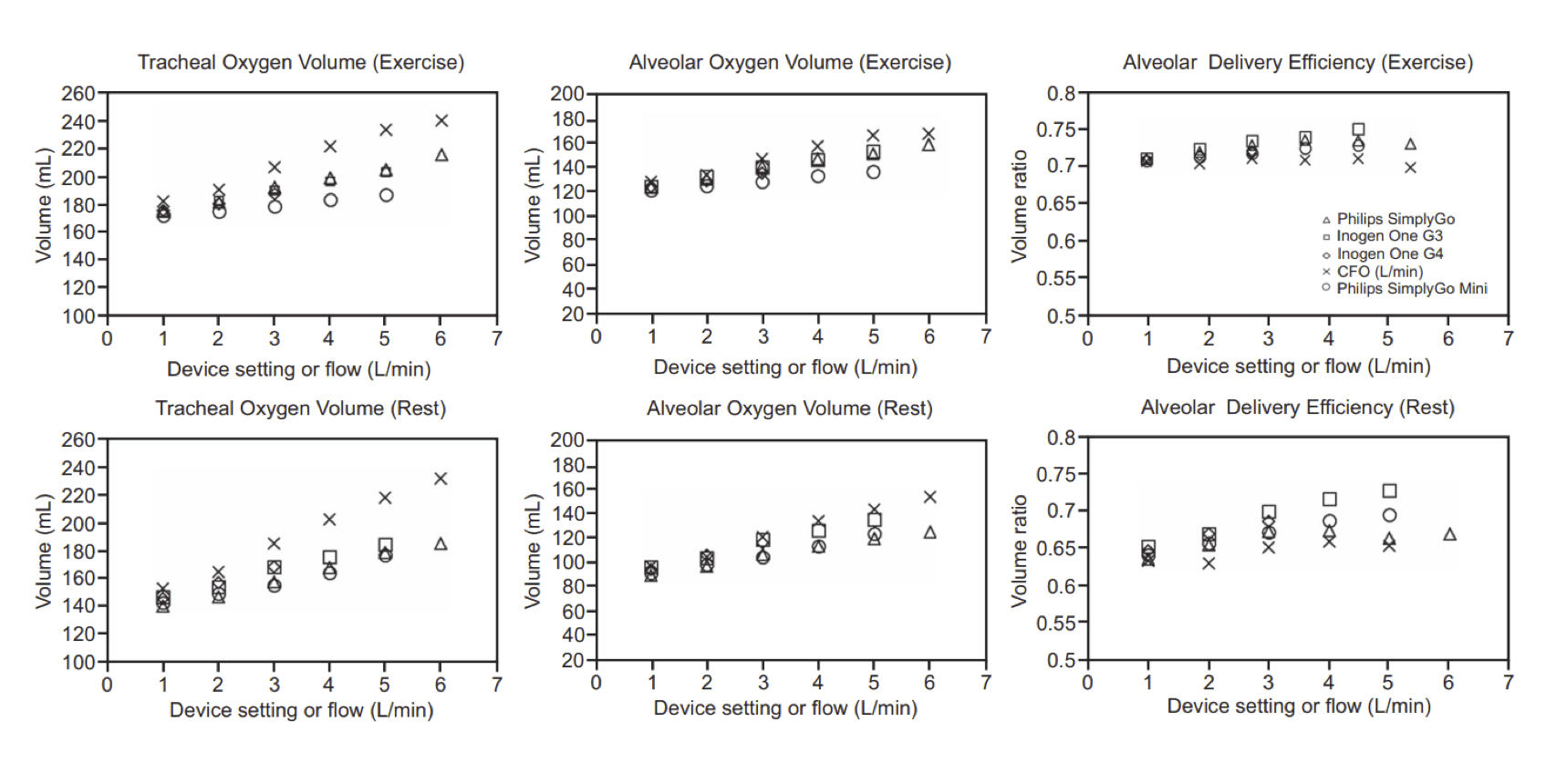Comparing Portable to Stationary Oxygen Concentrators
Nov 8 2023
The comparison of how well a Pulse Dose Flow (PDF) portable oxygen concentrator is able to saturate a patient, compared to Continuous Flow (CF) still remains widely unknown. There’s a good reason – there are not enough studies published on the subject.
Portable Oxygen Concentrators (POCs) deliver oxygen for a short duration, or a pulse. These are called boluses. A bolus of oxygen will only be given when the patient inhales. A patient’s inspiration is detected and the POC releases the bolus. Continuous flow, or Stationary Concentrators (SOCs) provide a constant stream of oxygen irrespective of whether the patient is inhaling or not. Therefore, a POC requires less electric power and needs to product less total oxygen to keep a patient’s oxygen levels high.
The reason why a true comparison is hard to make is evidenced in the studies. Here, we must state that we are not physicians, and can’t offer medical advice. But below, we will share some of the science and studies that show how PDF and CF can be compared. The only reliable way to measure a patient’s oxygen level is by using a pulse oximeter to check a patient’s SpO2 rate which measures the saturation of oxygen in their blood.
The main goal of supplemental oxygen therapy is ensuring the patients SpO2 level stays at a healthy level dependent on their existing diagnosis. The Golden Rule with portables is to increase the Pulse Setting by 1 setting if the patient is not fully saturated.
Why it’s Hard to Make the Comparison:
- Not all portables have the same oxygen output per each setting, which usually range from 1 to 5 or 6. As an example, the Inogen G5/Rove6 produces 1260 mL oxygen at setting 6, which is the highest oxygen output for any POC in the world. The same is true for the Oxlife Independence.
- POCs are designed to saturate a patient when the patient is mobile, giving them freedom. The body requires more oxygen when moving and exercising. Even a patient using a SOC would need more oxygen while, for example, jogging on a treadmill, but it is difficult for a patient to use a SOC while exercising. Therefore, it is hard to measure saturation while exercising on a SOC to make a true comparison between POCs and SOCs.
- Human biology also plays a part. Patients have different breathing patterns, some naturally inhale deeper, while some have a shallower breath and a correspondingly higher breath rate.
- The trigger sensor on POCs varies. This is an important part of a POC successfully saturating a patient as the bolus must match when a patient inhales. If it doesn’t, the oxygen will not reach deep in the lungs to enter the patient’s blood, meaning the patient will not be saturated. The iGo2 has the most sensitive trigger mechanism of all POCs.
Studies:
A 2019 study published in the Respiratory Care Journal supports the PDF vs CF comparison. Using in vitro bench top modeling incorporating a realistic upper airway replica and simulated breathing, the study summarizes the following:
- For the POCs evaluated, the absolute volume of oxygen delivered to the alveoli per breath was predicted to be greater for CF oxygen than for PDF oxygen across the majority of cases studied. However, the study continues to show that sufficient oxygen was delivered by POCs to the alveoli to saturate a patient. This is why titration on a POC is so important.
- Fractional inspired oxygen (FiO2) or what percentage of oxygen is inhaled, found in the trachea, was higher for CF compared with PDF at nominally equivalent flows and/or POC numerical settings. This means more oxygen was found in the upper airways where it is not affecting a patient’s blood oxygen saturation in a SOC than a POC. Any oxygen here is not impacting the patient’s SpO2 level so it is less important.
- When the in vitro data were combined with in silico modeling, it was predicted that PDF, compared with CF, delivers oxygen more efficiently to the alveoli in the lung. The alveoli are where the blood gas exchange happens, so this is the most important part of the lungs that oxygen needs to reach to have an impact on the patient’s SpO2 level.
The below data from the study tabulates the comparison:

Statistical Analysis:
Tracheal Oxygen Volume: The PDF volume is not as high as the CF volume. These are the least important graphs as they measure the volume in the Trachea; it’s the Alveolar Oxygen Volume that is important as this is where the oxygen enters the bloodstream and saturates the body.
The Alveolar Oxygen Volume: The PDF volume is slightly lower than the CF volume. The Inogen G3 (□) and the Philips SimplyGo (△) have the highest Volume (mL) and are the closest to the CF volume. SimplyGo has a 6th pulse setting, similar to the Inogen G5 and the Oxlife Independence.
A further correlation can be made between the Exercise and Rest comparisons where the Inogen G3 at setting 4 is equal to the CF setting at 3L/min. At setting 5, Inogen G3 is equal to the CF setting at 4L/min. This is in line with the Golden Rule that patients should be titrated or educated to increase their POC setting by 1 level compared to their CF prescription as needed.
Since most mobile patients have a CF prescription of 2-3LPM, the available high quality POCs on the market have sufficient oxygen to keep these patients saturated at settings up to 6.
Alveolar Delivery Efficiency: These graphs show how much oxygen is found in the alveolar region of the lungs as a percentage of the total oxygen delivered. POCs are extremely efficient, especially during exercise in ensuring the oxygen delivered is reaching the alveoli, and therefore improving the patient’s SpO2 levels and keeping them oxygenated. The Alveolar Delivery Efficiency of the Inogen G3 is higher than that of the CF concentrator.
Please read the full study here.
Other Studies:
- A study published in the Respiratory Care Journal evaluates patient preferences suffering with COPD between a POC and an oxygen cylinder. The study reported no significant differences in oxygen saturation between the POC and cylinder. Please read the full study here. The study found the following benefits:
- Improved Mobility: Pulse dose technology allows patients to be more mobile and active because they no longer need to be tethered to stationary oxygen machines.
- Enhanced Comfort: Patients often report increased comfort with pulse dose technology as it delivers oxygen precisely when needed during inhalation, reducing dryness and discomfort in the nasal passages.
- A case study published in the Respiratory Care Journal examined the experiences of patients transitioning from CF therapy to PDF technology. Read the full study here.The study found the following benefits:
- Improved Quality of Life: Patients reported a significant improvement in their overall quality of life. They felt more in control of their oxygen therapy and enjoyed greater freedom to engage in daily activities.
- Enhanced Sleep Patterns: Many patients experienced better sleep patterns and improved rest, resulting in increased energy levels during the day.
- Reduced Anxiety: The precise and responsive delivery of oxygen reduced anxiety levels among patients who previously worried about running out of oxygen during exertion or sleep.
- Decreased Hospital Readmissions: The study also noted a reduction in hospital readmissions among patients using pulse dose technology, indicating better disease management and overall health outcomes.
- CF produced significantly higher FiO2 at all settings for normal lungs but lower for COPD lungs compared with a POC. While patients diagnosed with COPD had a lower FiO2 on PDF devices, the difference compared to CF devices was lower than patients with healthy lungs. Data show there is no equivalency between PDF setting and CF rates for the portable oxygen concentrators tested. This study goes on to support the recommendation that clinicians and caretakers should titrate the PDF setting to each patient's unique oxygen requirements. Please read the full study here.
Video: Learning about the comparison of pulse flow dose and continuous flow video.
Stationary and Portable Concentrator US Market Insights:
In 2022, the fixed medical oxygen concentrators (SOCs) segment held the majority US market share of 53.8%. This can be attributed to factors such as the growing geriatric population, a large base of long-term patients, and increasing demand for these devices in hospitals.
The portable medical oxygen concentrators segment (46.2%) is expected to experience the fastest CAGR of 7.0% during the forecast period. This growth is driven by increasing awareness of the benefits associated with the use of portable concentrators. There is a rising demand for portable medical oxygen concentrators due to the increasing number of mobile patients who require out of home solutions. According to the medical oxygen device industry, approximately 80% of U.S. long-term oxygen therapy users utilized ambulatory oxygen, meaning they needed oxygen while moving around, while only the remaining 20% were considered stationary. This data highlights the growing demand and utilization of portable medical oxygen concentrators.
Conclusion:
In recent years, the advent of pulse dose technology has marked a significant advancement in oxygen therapy, enhancing the quality of life for patients worldwide. However, many physicians and patients still don’t understand the comparison between continuous flow and pulse dose flow. The above studies show that the alveolar oxygen delivery, and alveolar delivery efficiency produced by reputable POCs either compares to, or is similar to that of stationary, continuous flow concentrators.
The studies go on to support that there are many additional advantages when a patient uses a POC. These include improved mobility, improved freedom and exercise, enhanced comfort, improved quality of life, and decreased hospital readmissions.
The US POC market share is about to overtake that of stationary concentrators, and the European markets are very similar. Physicians will benefit by understanding the above information and the additional health advantages to promote the availability and wider use of portable concentrators to improve the quality of their patients’ lives.

Copyright Sanrai 2020
